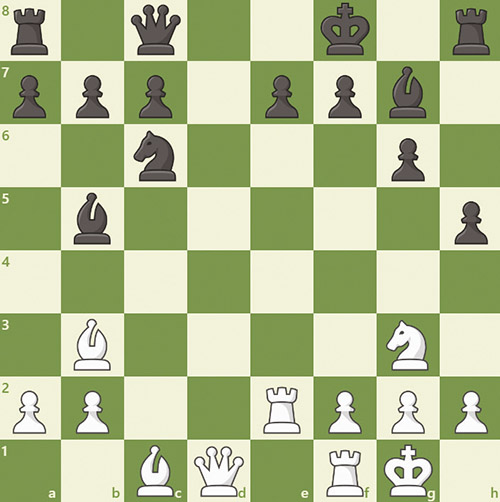
In chess, Danger Levels, a concept coined by the popular chess streamer and YouTuber GothamChess, is a moment when your opponent is attacking you, but you have a move that is equally or exceedingly threatening, to which your opponent must respond, saving or winning the game. This idea is demonstrated in Figure 1, where the black bishop is skewering the white rooks so if one moves, the other can be taken. However, white has the move queen to d5, ignoring the attack on the rooks and instead both hitting the bishop and threatening checkmate with Queen takes f7. As to stave off immediate defeat, black has to prevent checkmate with a move like e6, and then white can take the bishop with his queen, winning material and preventing it from taking white’s rooks. See if you can find the danger levels used in Dina Belenkaya’s powerful attacking sequence and the role of this idea in the puzzles below.
Figure 2 is a position from the recent chessboxing event, a sport in which two players alternate for periods of time between boxing and a game of chess, between chess streamer Andrea Botez and Woman Grandmaster Dina Belenkaya, hosted by the popular streamer Ludwig. During their blitz chessboxing match, Dina, playing with the black pieces, launched a massive attack against Andrea, who proved herself to be the stronger boxer; to truly experience the excitement and intensity of the game, I would recommend actually watching the match online. From this slightly better for white position, Andrea played Bc2 to avoid losing her bishop, Dina lashed out with e5, pressuring the center, and Andrea responded with d5, trying to keep the center closed and attacking the black knight. Utilizing the idea of danger levels, Dina then played e4, threatening to take white’s knight on f3 with a discovered check while ignoring the threat on her c6 knight. To maintain relative equality, white must castle queenside (0-0-0) to disallow a kingside attack but Andrea inaccurately played 0-0, casting kingside to avoid the discovered check that would come with exf3. 5 0-0 Ne5, 6 Nd4 f3, using her pawns to launch a dangerous attack on the white king’s defenses.

Here, it is best for white to play gxf3 but, not wanting to open up her king, Andrea played g3 which is a massive mistake that allows Dina to penetrate the kingside with her queen, knight and pawns. Then with 7 g3 h5 8 Nb5 Bh6 9 Qd1 Qg5, Dina uses danger levels twice in a row, ignoring the threat of a knight forking the king and rook on c7 and instead playing Bh6, attacking the white queen, and then Qg5, sacrificing the rook for the attack. 10 Nxc7+ Kf7 11 Kh1 Qg4 12 d6 Qh3 and Dina has a forced checkmate by threatening both Qg2# and to bring the knight into the attack. 13 Bb3+ Kg6 14 Rg1 Ng4 15 Nxf3 exf3, exhausted from the boxing and playing quickly, Dina misses Nxf2# mate in 1 but the game is over anyhow. 16 Bf7+ Kh7, a particularly tense moment as they entered their final stage of boxing; if Andrea succeeded in knocking out Dina, she would win but if not, Dina would checkmate her on the chessboard. In a somewhat controversial turnout, Andrea failed to knock out Dina and after 17 Bg6+ Kxg6, Andrea resigned.
In Figure 3, a position from an online game of mine, black’s queen is under attack from white’s rook and has no safe squares to escape to. However, black can use the concept of danger levels and play bishop to f5, counter attacking white’s queen with an undefended bishop. If the white queen takes the bishop, then the rook on a4 is left undefended, and if Qb3 to save the queen and continue to protect the rook, Qxb3 Bxb3 and black is much better. After Bf5, the best move is actually Bxf7 and if the king takes it, e4 attacks the bishop and blocks its attack against the white king, as well as maintaining the threat to take the black queen. If Bxe4, the best move, then white has Ng4+, forking the king and bishop and the position is equal.
Figure 4 is a complicated position from the 2021 World Blitz Championship between Pawel Teclaf and Tigran Petrosian. White is up 3 points of material, however, the black bishop is attacking the white queen and black has a possibly dangerous attack against white’s king. The natural Qxd7, winning the piece, loses to a forced checkmating sequence of … Qb4+ 3. Kc1 Bb2+ 4. Kb1 Ba3+ 5. Ka1 Qb2#. If white were to play a move like Qd2 to avoid getting captured, black has Qa3 and a winning attack against the white king; if white plays Qe7 to prevent Qa3, black has Qc3 threatening checkmate and is completely winning. The correct move in this position, utilizing the idea of danger levels, is to move the bishop back to d2 and counterattack the black queen so that if Bxd6, Bxa5 and white is simply up material with a better position. Qa4 fails to Qxd7 as the bishop prevents the Qb4+ mating pattern outlined earlier, after Qd8, white simply moves their queen back and after b4, which was played in the game, white has Qxb4 with a crushing advantage.

Ethan Feder is a junior at Yeshivat Frisch, a chess enthusiast and player. The goal of his column is to teach and discuss chess concepts through example positions, high-level games and relevant puzzles, along with explanations. Feel free to contact him with any questions, suggestions or comments at [email protected].











